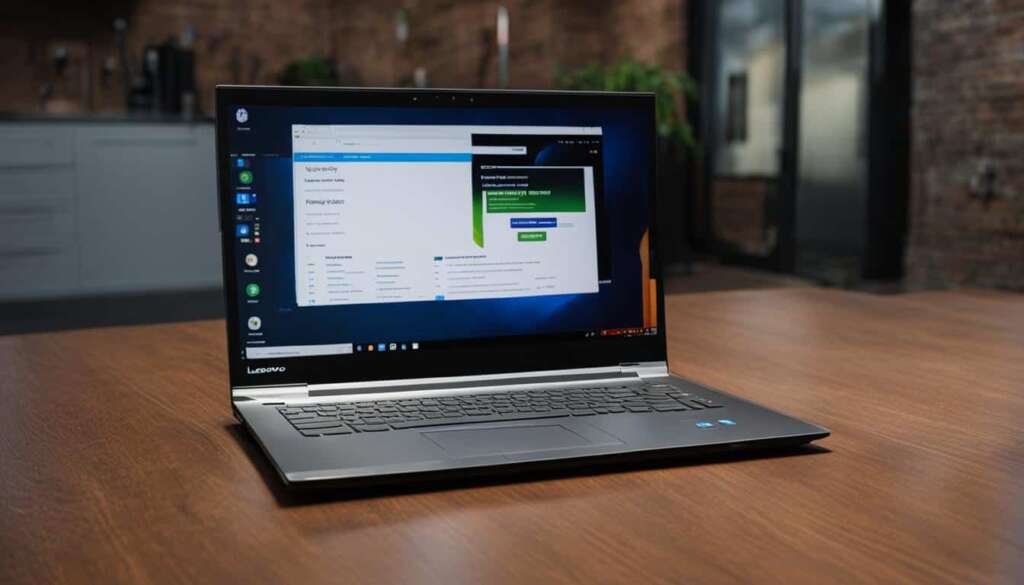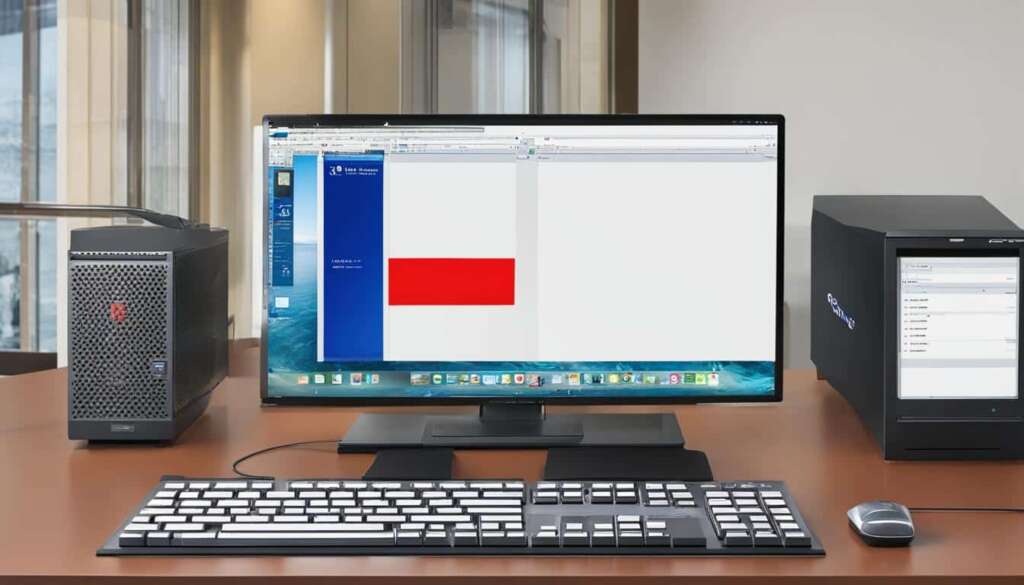Table of Contents
Is your Dell laptop running slow or plagued with software-related issues? Don’t worry, there’s a simple solution that can restore its performance and get it back to its former glory. By performing a factory reset, you can revive your Dell laptop and enjoy a seamless computing experience once again.
When a Dell laptop encounters troubleshooting problems or fails to start up, a factory reset can work wonders. It reinstalls the operating system, eliminating any software-related issues that may be slowing down your laptop or causing it to malfunction. Whether you’re dealing with a sluggish performance or a laptop that won’t even boot, a factory reset can be the answer.
Restore Your Computer Using SupportAssist OS Recovery
If you’re experiencing issues with your Dell laptop and it can’t boot into the operating system, SupportAssist OS Recovery is here to help. This recommended method provides a dedicated recovery environment that can diagnose hardware problems, backup your files, repair the computer, or restore it to factory defaults.
SupportAssist OS Recovery automatically initiates when your laptop encounters booting difficulties, offering a seamless path to recovery. Whether you’re facing hardware malfunctions or simply want to start fresh, this powerful tool has got you covered.
To restore your computer using SupportAssist OS Recovery, all you need to do is follow the step-by-step instructions provided by Dell Technologies. These instructions will guide you through the entire process, ensuring a hassle-free restoration of your Dell laptop.
With SupportAssist OS Recovery, you can regain control over your laptop’s performance and resolve any hardware-related issues that may be hampering its functionality. This user-friendly tool is designed to simplify the restoration process, making it accessible to users of all technical backgrounds.
Don’t let software problems hold you back. Experience the convenience of SupportAssist OS Recovery and get your Dell laptop back on track in no time.
Restore the Operating System Using a Dell Operating System Recovery Image
Another option for restoring a Dell laptop is to use a Dell operating system recovery image. This method allows you to reinstall the operating system and restore your laptop to its original factory image.
To get started, you can learn how to download and use the Dell operating system recovery image in Microsoft Windows or Ubuntu/Linux. Simply follow the step-by-step instructions provided by Dell Technologies.
If you don’t have access to a working Windows computer to create a USB recovery media, don’t worry. There are instructions available on how to download and use the recovery image in Ubuntu or Linux.
However, before proceeding with the restoration process, it’s important to note that it will format the hard drive and remove all data. Therefore, it is highly recommended to back up your files beforehand to avoid any potential data loss.

Instructions for using the Dell operating system recovery image
| Operating System | Instructions |
|---|---|
| Microsoft Windows | 1. Visit the Dell support website and enter your laptop’s service tag or model to find the relevant recovery image. |
| 2. Download the recovery image and create a bootable USB drive using the Dell USB Recovery Tool. | |
| 3. Connect the USB drive to your Dell laptop and boot from the USB drive. | |
| 4. Follow the on-screen instructions to restore the operating system using the recovery image. | |
| Ubuntu/Linux | 1. Visit the Dell support website and enter your laptop’s service tag or model to find the relevant recovery image. |
| 2. Download the recovery image and create a bootable USB drive using the appropriate tools for Linux. | |
| 3. Connect the USB drive to your Dell laptop and boot from the USB drive. | |
| 4. Follow the on-screen instructions to restore the operating system using the recovery image. |
Alternate Recovery and Reinstall Options for Different Windows Versions
When it comes to Windows operating systems, there are various recovery and reinstall options available for different versions. Whether you’re using Windows 11, Windows 10, Windows 8.1, or Windows 7, you can choose the most suitable method to restore or reinstall Windows based on your specific needs.
Windows 11 and Windows 10
For Windows 11 and Windows 10 users, you have two primary options for restoring your system. The first option is to reset your system from within the operating system itself. This allows you to keep your files and settings while reinstalling and refreshing the Windows installation. The second option is to perform a system restore, which allows you to revert your system back to a previous point in time when it was functioning properly.
Windows 8.1
If you’re using Windows 8.1, you can manually reinstall the operating system using the installation media. This method involves creating a USB recovery media or using a DVD to reinstall Windows 8.1. Alternatively, you can also use the built-in system restore feature to return your system to a previous state and resolve any issues.
Windows 7
For Windows 7 users, there are multiple recovery and reinstall options available. You can use computer restore points to restore your system back to a previous state. If that’s not possible, you can reset your system to factory settings, which is particularly useful if you want to start fresh with a clean installation. Additionally, you can manually install Windows 7 using installation media, allowing you to customize the installation process.
Dell provides detailed instructions for each recovery and reinstall option based on your Windows version. By following these instructions, you can easily restore or reinstall Windows on your Dell laptop and resolve any issues you may be experiencing.
| Windows Version | Recovery and Reinstall Options |
|---|---|
| Windows 11 and Windows 10 | Reset within the operating system Perform system restore |
| Windows 8.1 | Manually reinstall the operating system Use system restore |
| Windows 7 | Use computer restore points Reset to factory settings Manually install Windows |
With these alternate recovery and reinstall options, you can easily restore the performance and functionality of your Dell laptop. Choose the method that best suits your Windows version and get ready to experience a seamless computing experience.
Conclusion
Performing a factory reset on your Dell laptop can bring numerous benefits to enhance the performance and functionality of your device. By resetting your laptop to its factory settings, you have the opportunity to troubleshoot various issues and enjoy a fresh start with a clean installation of the operating system.
Prior to initiating a factory reset, it is crucial to back up your valuable data using reliable methods such as File History or other backup options. This ensures that you can safely restore your important files and avoid any potential data loss during the reset process.
To effortlessly revive your Dell laptop, it is recommended to follow the detailed instructions provided by Dell Technologies. These instructions will guide you through the entire process, allowing you to experience the benefits of a factory reset firsthand and unlock the full potential of your Dell laptop.
FAQ
How can I restore my Dell laptop to its factory settings?
There are multiple options for restoring a Dell laptop to its factory settings. You can use SupportAssist OS Recovery, a recovery environment that helps diagnose hardware issues, backup files, repair the computer, or restore it to factory defaults. Another option is to use a Dell operating system recovery image, which allows you to reinstall the operating system and restore your laptop to its original factory image. There are also alternate recovery and reinstall options available for different versions of Windows. It is recommended to back up your files before attempting a factory reset.
How do I restore my Dell laptop using SupportAssist OS Recovery?
SupportAssist OS Recovery is a recommended method for restoring a Dell laptop. When your computer cannot boot into the operating system, SupportAssist OS Recovery automatically starts and provides a recovery environment. It helps diagnose hardware issues, backs up files, repairs the computer, or restores it to factory defaults. You can learn how to restore your computer using SupportAssist OS Recovery by following the instructions provided by Dell Technologies.
How do I restore the operating system on my Dell laptop using a Dell operating system recovery image?
To restore the operating system on your Dell laptop, you can use a Dell operating system recovery image. This method allows you to reinstall the operating system and restore your laptop to its original factory image. You can learn how to download and use the Dell operating system recovery image in Microsoft Windows or Ubuntu/Linux. It is important to note that this process formats the hard drive and removes all data, so it is recommended to back up your files before proceeding.
What are the alternate recovery and reinstall options for different versions of Windows on a Dell laptop?
There are different recovery and reinstall options available for different versions of Windows. For Windows 11 and Windows 10, you can reset your system within the operating system or perform a system restore. For Windows 8.1, there are instructions on how to manually reinstall the operating system or use system restore. For Windows 7, there are options for using computer restore points, resetting to factory settings, or manually installing Windows. Dell provides knowledge base articles with detailed instructions for each option, allowing you to choose the most suitable method based on your Windows version and specific needs.
What are the benefits of performing a factory reset on my Dell laptop?
Performing a factory reset on your Dell laptop can have multiple benefits. It can restore the performance of your laptop, troubleshoot issues, and provide a fresh start with a clean installation of the operating system. It is recommended to back up your files using File History or other backup methods before attempting a factory reset to avoid data loss.













